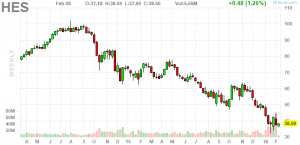We have been warning people about the insanity (and you can almost call it corruption) in the share buyback programs. In our post on the October 19th (https://l2capital.com.br/pt/morgan-stanley-ibm-e-o-fed/), we predicted what was going to happen to several companies as soon as the FED raised interest rates: the companies were showing higher profits merely because they were leveraging up (a lot, by the way) at very low interest rates in order to buy back their shares. By doing so, they reduce the number of shares available and hence increased the earnings-per-share (EPS) – not because of valuation fundamentals, rather because they were using the oldest trick on earth to boost their profits.
As widely predicted by us, that just couldn´t end up well! Not shockingly, that is what happened to Hess (and what is set to happen to many others). Instead of taking the opportunity to invest in Research & Development, new business, internationalization, new processes, etc, the company was “forced” to start buying shares back in 2013. In the process, the debt has increased substantially.
In the beginning, there was nothing to complain about: the shares, back then trading at about US$60, surged to nearly US$100. Today they are trading at less than US$40 and what we predicted unfortunately did happen: the company had no choice but to sell shares at US$39 to maintain liquidity and avoid insolvency!!! That`s value destruction at its best: after the company had purchased shares at an average price of US$83, using shareholders funds, it had to sell those shares, less than two years later, for only US$39.

Very few have managed to enjoy the ride and make money on the way up, selling the stock close to the highs. The great majority did not! It is important to notice that most buybacks take place on market highs. They manage to keep share prices high for a while, but the shares eventually have to face reality – and it is definitely not pleasant.
Most of our short positions in the USA are stocks of companies that did buybacks. We didn`t bet in the upward movement, because of the inherent risks, but we are now participating in the downturn movement with astronomic profits so far. Our portfolios are up more than 10% year-to-date.
We still recommend our investors caution, cash and a small allocation to physical precious metals for the time being.


